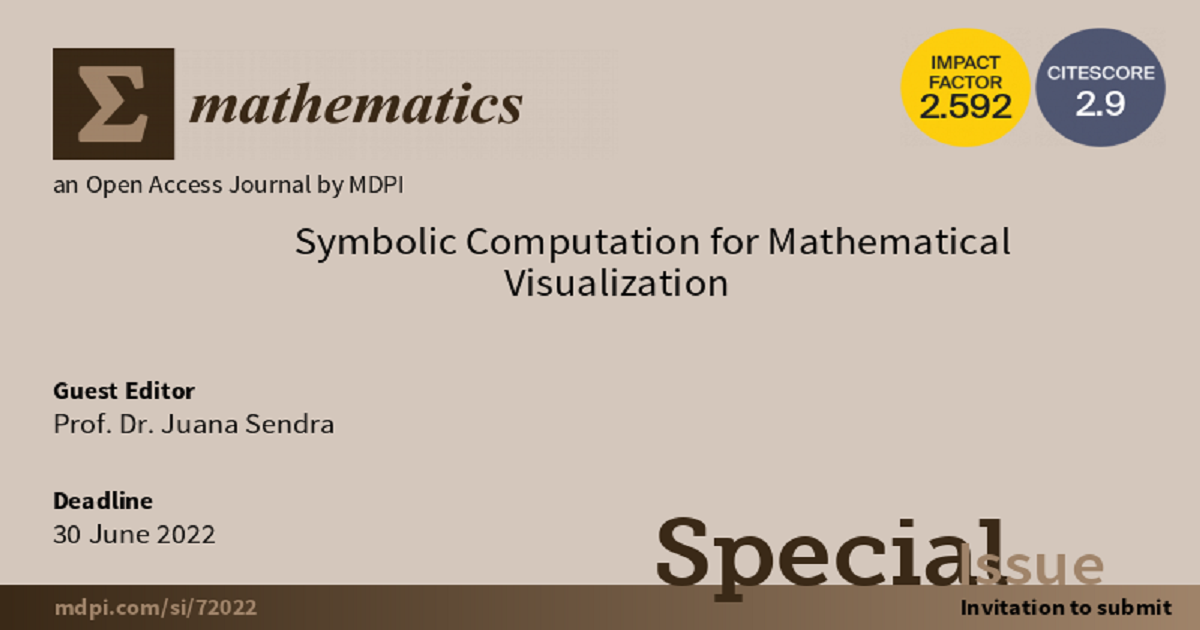Symbolic Computation for Mathematical Visualization
A special issue of Mathematics (ISSN 2227-7390). This special issue belongs to the section "E1: Mathematics and Computer Science".
Deadline for manuscript submissions: closed (20 January 2023) | Viewed by 13216

Special Issue Editor
Interests: visualization of curve and surface properties: algorithms and applications; symbolic computation for computer-aided geometric design; symbolic computation for algebraic geometry; visualization of matrix properties: algorithms and applications; symbolic computation for linear algebra and multilinear algebra; hybrid (approximate and symbolic) methods for the visualization of mathematical properties and proofs
Special Issue Information
Dear Colleagues,
The fundamental objects of study in algebraic geometry are algebraic varieties, which are geometric manifestations of solutions of systems of polynomial equations. Examples of the most studied classes of algebraic varieties are: plane algebraic curves and surfaces. Richard S. Palais, in his work “The Visualization of Mathematics: Towards a Mathematical Exploratorium. Notices of the American Mathematical Society 46, 647-658, 1999”, indicated:
“Creating visualizations of implicitly defined curves and surfaces leads to many interesting
problems, both for the mathematician and for the programmer. The need to solve the equations involved numerically is one major difficulty. Constructing reliable and efficient algorithms for finding all the solutions when there are no restrictions on permitted singularities is not a completely solved problem. This is so even for the important special case of interest to algebraic geometers, namely, when the objects in question are defined as the solutions of polynomial equations. Another difficulty is that implicitly defined surfaces do not come equipped with a natural grid, and so special techniques (such as so-called “ray-tracing” methods) must be used to render them. Because of these challenges (and the importance of algebraic geometry), …….”
Computational algebraic geometry is an area that has emerged at the intersection of algebraic geometry and computer algebra, with the rise of computers. It consists mainly of algorithm design and software development for the study of properties, as well as their applications, of explicitly given algebraic varieties.
The visualization of mathematics, consisting of the visualization of objects, and mathematical structures and methods, focuses on the development of intuition and mental models that
provide answers to questions that may arise within and outside of the mathematics.
The central goal of this Special Issue is to collect original contributions in the common intersection area of symbolic computation, algebraic geometry and/or visualization of mathematics.
Prof. Juana Sendra
Guest Editor
Manuscript Submission Information
Manuscripts should be submitted online at www.mdpi.com by registering and logging in to this website. Once you are registered, click here to go to the submission form. Manuscripts can be submitted until the deadline. All submissions that pass pre-check are peer-reviewed. Accepted papers will be published continuously in the journal (as soon as accepted) and will be listed together on the special issue website. Research articles, review articles as well as short communications are invited. For planned papers, a title and short abstract (about 100 words) can be sent to the Editorial Office for announcement on this website.
Submitted manuscripts should not have been published previously, nor be under consideration for publication elsewhere (except conference proceedings papers). All manuscripts are thoroughly refereed through a single-blind peer-review process. A guide for authors and other relevant information for submission of manuscripts is available on the Instructions for Authors page. Mathematics is an international peer-reviewed open access semimonthly journal published by MDPI.
Please visit the Instructions for Authors page before submitting a manuscript. The Article Processing Charge (APC) for publication in this open access journal is 2600 CHF (Swiss Francs). Submitted papers should be well formatted and use good English. Authors may use MDPI's English editing service prior to publication or during author revisions.
Keywords
- constructive algebraic geometry
- mathematical visualization
- symbolic computation
- hybrid computation
- geometric computation
- non-linear algebra
- linear and multilinear algebra
Benefits of Publishing in a Special Issue
- Ease of navigation: Grouping papers by topic helps scholars navigate broad scope journals more efficiently.
- Greater discoverability: Special Issues support the reach and impact of scientific research. Articles in Special Issues are more discoverable and cited more frequently.
- Expansion of research network: Special Issues facilitate connections among authors, fostering scientific collaborations.
- External promotion: Articles in Special Issues are often promoted through the journal's social media, increasing their visibility.
- Reprint: MDPI Books provides the opportunity to republish successful Special Issues in book format, both online and in print.
Further information on MDPI's Special Issue policies can be found here.





